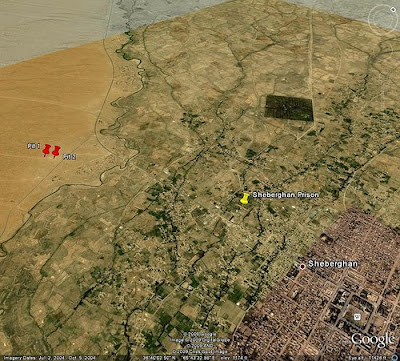On 30th December, in a hearing related to the Dasht-e-Leili 'Convoy of Death', a US federal judge criticised the Department of Defense (DoD) for its weak response to a Freedom of Information request by Physicians for Human Rights (PHR). The judge ruled that DoD agencies should have searched for, and handed over, relevant documents existing between 1st November 2001 and now, rather than merely documents existing in November and December 2001.
The ruling gives a boost to the efforts of PHR and others, in our claim that US government agencies have been suppressing evidence relating to war crimes. The suppressed documents may corroborate claims that the bodies of up to a couple of thousand prisoners were buried in a mass grave site at Dasht-e-Leili in northern Afghanistan, at the end of 2001.
The DoD agencies, including Central Command and the Defence Intelligence Agency must comply with the ruling by no later than April.
Here's a report of the hearing from the Maryland Daily Record:
http://mddailyrecord.com/2009/12/30/federal-judge-orders-dod-to-supply-taliban-papers/
December 30, 2009
Federal judge orders DoD to supply Taliban papers
By Brendan Kearney <brendan.kearney@mddailyrecord.com>
Daily Record Legal Affairs Writer
The U.S. Department of Defense did not adequately respond to a human rights group’s Freedom of Information Act request for documents related to the American investigation of a Taliban mass grave in northern Afghanistan, a federal judge in Baltimore ruled Wednesday, representing a “substantial” victory for government transparency advocates.
The U.S. Central Command, a DoD component agency known as CENTCOM, must now conduct a temporally broader search for internal documents related to the Dasht-e-Leili gravesite, and the Joint Staff and Defense Intelligence Agency must submit to U.S. District Judge Richard D. Bennett certain documents it had previously turned over to the Physicians for Human Rights only in redacted form.
Judge Bennett, who is handling the Washington, D.C., case because the district court there is overworked, otherwise ruled for the government defendants, determining that they had performed a reasonably thorough search and that they offered legitimate reasons for redacting portions of the relevant documents.
The decision, which comes during a presidential administration that has promised to be more forthcoming in response to FOIA inquiries, offers a series of important reminders, according to Eugene R. Fidell, president of the National Institute of Military Justice.
“It’s a substantial victory, and it’s a reminder of the importance of FOIA,” said Fidell, who has submitted many FOIA requests to the Defense Department with “uneven” results and teaches at Yale Law School. “It is a reminder that we have someone looking over the government’s shoulder to enforce transparency. … It’s a reminder that the federal court helps the government turn square corners.”
Nathaniel Raymond, who has led the Physicians for Human Rights investigation into what happened at Dasht-e-Leili in late 2001, said the plaintiff organization is “heartened” by Bennett’s decision, “but the proof is in the pudding with what the Department of Defense produces.”
“We still don’t fully know what the U.S. knew, when they knew it, and how they knew it,” Raymond said. “But what we do know is this: Department of Defense personnel, namely the Special Forces teams on the ground … were operating with Northern Alliance forces at the time of the massacre.”
A Pentagon spokesman said only that the “DoD will review the ruling and take the appropriate action.”
The events underlying the lawsuit allegedly occurred in the months following the post-9/11 U.S. invasion of Afghanistan and the ouster of the ruling Taliban.
According to media reports, several thousand Taliban fighters surrendered to the Northern Alliance, an anti-Taliban coalition in Afghanistan, after a battle in Konduz. The defeated Taliban were then transported, in sealed cargo containers, 200 miles to a Northern Alliance prison in the city of Sheberghan, according to Bennett’s memorandum opinion.
During the journey, approximately 1,000 of the prisoners died of asphyxiation and were allegedly buried in a mass grave in nearby Dasht-e-Leili, according to the opinion. Raymond said he has seen State Department documents that have “a redacted three-letter intelligence agency” reporting an even higher body count.
Investigators from the Physicians for Human Rights, a Cambridge, Mass.-based nonprofit composed of health care professionals devoted to investigating alleged human rights violations, learned of the gravesite in January 2002 from Taliban prisoners at Sheberghan, according to a lengthy report in Newsweek magazine in August of that year.
Since then, the PHR has had only limited success in learning about the official American government investigation. It sued in February 2008 after the defendant agencies did not respond adequately to its June 2006 FOIA request. DOD, the State Department and the CIA have since provided approximately 60 documents to the PHR, some of which were heavily redacted.
In his 34-page opinion, Judge Bennett examined each defendant agency’s search procedures and explanations for what was not disclosed as laid out in their representatives’ affidavits. Most were “sufficiently detailed” or “not unreasonable under the circumstances,” he found, but with respect to the temporal scope of the search, the defendants interpreted PHR’s request “far too narrowly.”
“While the underlying events occurred in November and December of 2001, PHR have clearly requested all records ‘pertaining to’ or ‘relating to’ the underlying events, including any subsequent investigations,” Bennett wrote.
And in ordering the Defense Intelligence Agency to submit unredacted documents, Bennett found that division’s explanations for why their documents were exempt from disclosure “clearly deficient.”
CENTCOM must conduct its new search — from Nov. 1, 2001 to present, rather than just November and December of 2001 — then produce all responsive and non-protected information and renew its motion for summary judgment by April.
The Joint Staff must submit its September 2002 U.S. Space Command Situation Report and the DIA must, by February, submit two intelligence reports it claims contain code words and names of international organizations with which the DIA shared intelligence in one instance and geocoordinates and an evaluation of a classified source in the other.
